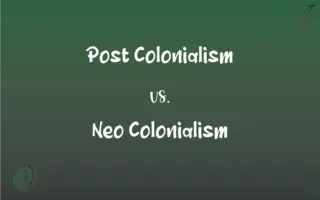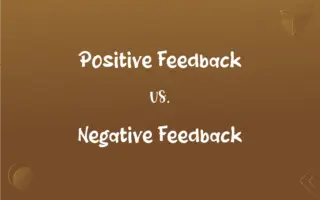Simple Permanent Tissue vs. Complex Permanent Tissue: What's the Difference?
Edited by Aimie Carlson || By Janet White || Published on January 3, 2024
Simple permanent tissue consists of similar cells performing a specific function, while complex permanent tissue comprises different cell types performing varied functions.

Key Differences
Simple permanent tissues in plants are made of similar types of cells that perform basic functions like photosynthesis, storage, or protection. Complex permanent tissues, however, consist of different types of cells that work together to perform specialized functions like transport.
Examples of simple permanent tissues include parenchyma, known for storage and repair, and collenchyma, which provides flexibility and support. Complex permanent tissues, such as xylem and phloem, are involved in the transport of water, minerals, and nutrients.
Simple permanent tissues are typically found throughout the plant body, including leaves, stems, and roots. Complex permanent tissues, however, are organized into specific systems, such as the vascular system, crucial for the plant's survival.
The simplicity of simple permanent tissues reflects their basic yet essential roles in plant life, whereas the complexity of complex permanent tissues underscores their crucial role in more specialized functions.
In terms of structure, simple permanent tissues are less diverse and complex compared to complex permanent tissues, which show a higher level of organization and specialization.
ADVERTISEMENT
Comparison Chart
Cell Types
Homogenous, similar cells
Heterogeneous, different cell types
Function
Basic plant functions like storage, support
Specialized functions like transport
Examples
Parenchyma, collenchyma, sclerenchyma
Xylem, phloem
Location in Plant
Throughout the plant body
Specific systems like the vascular system
Structural Complexity
Less complex, uniform structure
More complex, diverse structure
ADVERTISEMENT
Simple Permanent Tissue and Complex Permanent Tissue Definitions
Simple Permanent Tissue
Found throughout the plant, involved in essential tasks.
Collenchyma, as a simple permanent tissue, provides flexibility to plant stems.
Complex Permanent Tissue
Shows higher structural complexity and specialization.
In leaves, complex permanent tissue aids in the transport of nutrients.
Simple Permanent Tissue
Includes tissue types like parenchyma, collenchyma, and sclerenchyma.
In roots, simple permanent tissue helps in nutrient storage.
Complex Permanent Tissue
Composed of different cell types working together for specific functions.
Xylem, a complex permanent tissue, transports water in plants.
Simple Permanent Tissue
Tissue composed of similar cells performing basic functions.
Parenchyma, a type of simple permanent tissue, is crucial for plant storage and healing.
Complex Permanent Tissue
Key examples include xylem and phloem.
The xylem and phloem in roots facilitate water and food transport.
Simple Permanent Tissue
Characterized by homogenous cellular structure.
Sclerenchyma is a simple permanent tissue offering rigidity to plants.
Complex Permanent Tissue
Found in specific systems like the vascular system.
Complex permanent tissues form the vascular bundles in stems.
Simple Permanent Tissue
Less complex in organization compared to complex tissues.
Simple permanent tissue in leaves is involved in photosynthesis.
Complex Permanent Tissue
Involved in specialized functions like transport and support.
Phloem is a complex permanent tissue crucial for nutrient transport.
FAQs
What is simple permanent tissue?
It's plant tissue made of similar cells performing basic functions.
What functions do complex permanent tissues perform?
They specialize in transport and support functions in plants.
Where is simple permanent tissue found?
Throughout the plant, including leaves, stems, and roots.
What is complex permanent tissue?
Tissue comprising different cell types for specialized functions.
How do complex permanent tissues aid in plant growth?
By transporting water, minerals, and nutrients.
What's the role of xylem?
It's a complex tissue responsible for water transport.
Can simple permanent tissue provide plant support?
Yes, collenchyma and sclerenchyma provide support.
Are simple tissues involved in storage?
Yes, particularly parenchyma cells.
Are simple permanent tissues structurally complex?
No, they have a more uniform and less complex structure.
What are examples of simple permanent tissue?
Parenchyma, collenchyma, and sclerenchyma.
What are key types of complex permanent tissue?
Xylem and phloem.
Is sclerenchyma a simple or complex tissue?
It's a simple permanent tissue providing rigidity.
How does xylem differ from phloem?
Xylem transports water; phloem transports nutrients.
Is simple permanent tissue involved in photosynthesis?
Yes, particularly parenchyma cells in leaves.
How does phloem contribute to plant health?
As a complex tissue, it transports nutrients.
Are complex tissues found in all plants?
Yes, they're essential in all vascular plants.
Do complex tissues have diverse cell types?
Yes, they consist of various specialized cells.
Can simple permanent tissue repair damage?
Yes, particularly parenchyma cells.
What makes complex tissues essential in plants?
Their role in vital functions like nutrient transport.
Is collenchyma involved in flexibility?
Yes, it helps in providing flexibility to growing parts.
About Author
Written by
Janet WhiteJanet White has been an esteemed writer and blogger for Difference Wiki. Holding a Master's degree in Science and Medical Journalism from the prestigious Boston University, she has consistently demonstrated her expertise and passion for her field. When she's not immersed in her work, Janet relishes her time exercising, delving into a good book, and cherishing moments with friends and family.
Edited by
Aimie CarlsonAimie Carlson, holding a master's degree in English literature, is a fervent English language enthusiast. She lends her writing talents to Difference Wiki, a prominent website that specializes in comparisons, offering readers insightful analyses that both captivate and inform.






































































